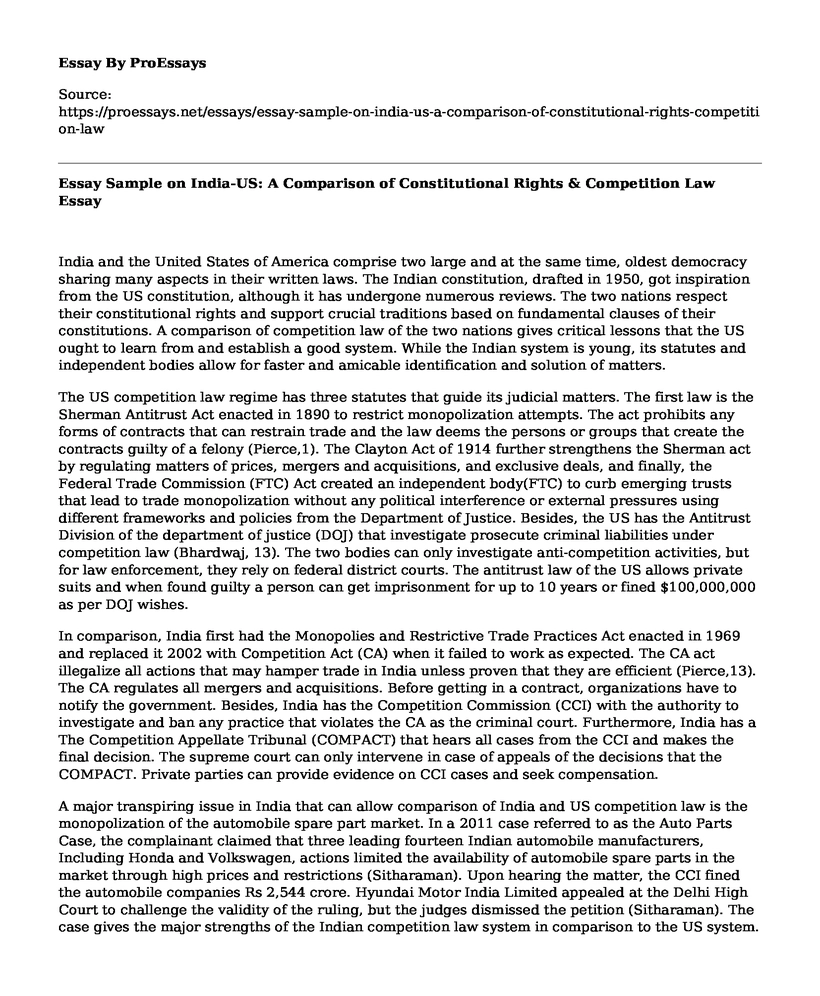India and the United States of America comprise two large and at the same time, oldest democracy sharing many aspects in their written laws. The Indian constitution, drafted in 1950, got inspiration from the US constitution, although it has undergone numerous reviews. The two nations respect their constitutional rights and support crucial traditions based on fundamental clauses of their constitutions. A comparison of competition law of the two nations gives critical lessons that the US ought to learn from and establish a good system. While the Indian system is young, its statutes and independent bodies allow for faster and amicable identification and solution of matters.
The US competition law regime has three statutes that guide its judicial matters. The first law is the Sherman Antitrust Act enacted in 1890 to restrict monopolization attempts. The act prohibits any forms of contracts that can restrain trade and the law deems the persons or groups that create the contracts guilty of a felony (Pierce,1). The Clayton Act of 1914 further strengthens the Sherman act by regulating matters of prices, mergers and acquisitions, and exclusive deals, and finally, the Federal Trade Commission (FTC) Act created an independent body(FTC) to curb emerging trusts that lead to trade monopolization without any political interference or external pressures using different frameworks and policies from the Department of Justice. Besides, the US has the Antitrust Division of the department of justice (DOJ) that investigate prosecute criminal liabilities under competition law (Bhardwaj, 13). The two bodies can only investigate anti-competition activities, but for law enforcement, they rely on federal district courts. The antitrust law of the US allows private suits and when found guilty a person can get imprisonment for up to 10 years or fined $100,000,000 as per DOJ wishes.
In comparison, India first had the Monopolies and Restrictive Trade Practices Act enacted in 1969 and replaced it 2002 with Competition Act (CA) when it failed to work as expected. The CA act illegalize all actions that may hamper trade in India unless proven that they are efficient (Pierce,13). The CA regulates all mergers and acquisitions. Before getting in a contract, organizations have to notify the government. Besides, India has the Competition Commission (CCI) with the authority to investigate and ban any practice that violates the CA as the criminal court. Furthermore, India has a The Competition Appellate Tribunal (COMPACT) that hears all cases from the CCI and makes the final decision. The supreme court can only intervene in case of appeals of the decisions that the COMPACT. Private parties can provide evidence on CCI cases and seek compensation.
A major transpiring issue in India that can allow comparison of India and US competition law is the monopolization of the automobile spare part market. In a 2011 case referred to as the Auto Parts Case, the complainant claimed that three leading fourteen Indian automobile manufacturers, Including Honda and Volkswagen, actions limited the availability of automobile spare parts in the market through high prices and restrictions (Sitharaman). Upon hearing the matter, the CCI fined the automobile companies Rs 2,544 crore. Hyundai Motor India Limited appealed at the Delhi High Court to challenge the validity of the ruling, but the judges dismissed the petition (Sitharaman). The case gives the major strengths of the Indian competition law system in comparison to the US system.
Although the Indian system excellent and fast in deciding when an issue jeopardizes competition. The CCI has both the investigative body and a tribunal to try and fine culprits based on CA. However, in the US, the matter would have taken years before resolution. It is the DOJ that investigates antitrust lawsuits, although all final decisions come from the court, which eventually takes a long time. Furthermore, the US system creates an environment that makes it challenging to identify culprits and legal principles. Both the DOJ, FTC, and the courts have roles that overlap and result in unnecessary complexities. Considerably, while the Indian system is relatively young, it has a lot of strengths that the US can emulate.
Works Cited
Bhardwaj, Sachin. "Frame Work Of Enforcement of The Competition Law In USA, EU and India." Journal of Corporate Governance & International Business Law 2.2 (2020).
Pierce Jr, Richard J. "Comparing the Competition Law regimes of the United states and India." National Law School of India Review 29.1 (2017): 1-17.
Sitharaman, Nirmala. "Hyundai Petition on Spare Part Sales Dismissed by Madras HC - Times of India". The Times of India, 2018, https://timesofindia.indiatimes.com/business/india-business/hyundai-petition-on-spare-part-sales-dismissed-by-madras-hc/articleshow/65155555.cms.
Cite this page
Essay Sample on India-US: A Comparison of Constitutional Rights & Competition Law. (2023, Apr 08). Retrieved from https://proessays.net/essays/essay-sample-on-india-us-a-comparison-of-constitutional-rights-competition-law
If you are the original author of this essay and no longer wish to have it published on the ProEssays website, please click below to request its removal:
- New Development Bank Impact on the Global Development Financing
- Critical Thinking Example: Will NAFTA Survive a Trump's Presidency?
- The International Business Environment Paper Example
- The International Organizations in Asia as a Sources of Stability Essay
- Case Study on the World Trade Organization
- CBP: Securing US Trade Through Maritime Ports - Essay Sample
- U.S Trade Deficit With China Reaches $26B in Jan 2020 - Essay Sample







